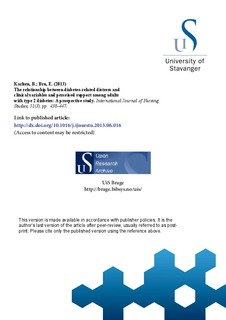| dc.contributor.author | Karlsen, Bjørg | |
| dc.contributor.author | Bru, Edvin | |
| dc.date.accessioned | 2017-01-13T10:13:52Z | |
| dc.date.available | 2017-01-13T10:13:52Z | |
| dc.date.issued | 2014-03 | |
| dc.identifier.citation | Karlsen, B.; Bru, E. (2014) The relationship between diabetes-related distress and clinical variables and perceived support among adults with type 2 diabetes: A prospective study.
International Journal of Nursing Studies, 51(3), pp. 438–447. | nb_NO |
| dc.identifier.uri | http://hdl.handle.net/11250/2427211 | |
| dc.description | This is an author accepted manuscript of an article originally published by Elsevier in the International Journal of Nursing Studies; http://dx.doi.org/10.1016/j.ijnurstu.2013.06.016. | nb_NO |
| dc.description.abstract | Background: Diabetes-related distress is a prevalent emotional state experienced among people living with type 2 diabetes. It has predominantly been studied in relation to diabetes management and metabolic control and to some extent in relation to perceived social support. Little is known about the relative prospective contribution of clinical variables and perceived support on diabetes-related distress.
Objective: To investigate the predictive influence of clinical variables and perceived support from health care professionals and family on diabetes-related distress.
Design: The study has a prospective, longitudinal design.
Settings: The participants were recruited from seven general practitioners in the south western part of Norway and from members of the Norwegian Diabetes Association.
Participants: The sample comprised 296 people with type 2 diabetes. Inclusion criteria were: adults (30–70 years) diagnosed with type 2 diabetes who were willing and able to complete a questionnaire written in Norwegian.
Methods: Data were collected by postal questionnaires assessing perceived support from health care professionals and family and diabetes-related distress measured by the Problem Areas in Diabetes Scale at two time points separated by an interval of one year (October 2008 and 2009). Clinical data were collected by self-report. The follow-up group, for which both assessment data were available, constituted our sample comprising 296 adults.
Results: Descriptive results and findings from correlations and prospective multivariate associations indicate small changes in diabetes-related distress over a period of one year. In total, multiple regression analyses showed that clinical variables were very weak predictors of diabetes-related distress, whereas perceived social support emerged as statistically significant although a moderate predictor of distress. Among the support variables, only ‘constructive support from health care professionals’ and ‘non-supportive family behaviour’ accounted for changes in diabetes-related distress.
Conclusions: Findings suggest that diabetes-related distress among adults with type 2 diabetes is relatively stable over time and may be difficult to alter. Health care professionals should therefore be aware that stimulating people to change is challenging and complex. Moreover, they should devote more attention to non-clinical factors such as social support when addressing diabetes-related distress. | nb_NO |
| dc.language.iso | eng | nb_NO |
| dc.publisher | Elsevier | nb_NO |
| dc.rights | Attribution-NonCommercial-NoDerivatives 4.0 Internasjonal | * |
| dc.rights.uri | http://creativecommons.org/licenses/by-nc-nd/4.0/deed.no | * |
| dc.subject | diabetes | nb_NO |
| dc.subject | diabetes type 2 | nb_NO |
| dc.subject | type 2 diabetes | nb_NO |
| dc.subject | clinical variables | nb_NO |
| dc.subject | diabetes-related distress | nb_NO |
| dc.subject | healthcare professionals | nb_NO |
| dc.subject | social support | nb_NO |
| dc.subject | prospective longitudinal study | nb_NO |
| dc.title | The relationship between diabetes-related distress and clinical variables and perceived support among adults with type 2 diabetes: A prospective study | nb_NO |
| dc.type | Journal article | nb_NO |
| dc.type | Peer reviewed | nb_NO |
| dc.rights.holder | (C) Elsevier | nb_NO |
| dc.subject.nsi | VDP::Medisinske Fag: 700::Klinisk medisinske fag: 750::Endokrinologi: 774 | nb_NO |
| dc.source.pagenumber | 438–447 | nb_NO |
| dc.source.volume | 51 | nb_NO |
| dc.source.journal | International Journal of Nursing Studies | nb_NO |
| dc.source.issue | 3 | nb_NO |

